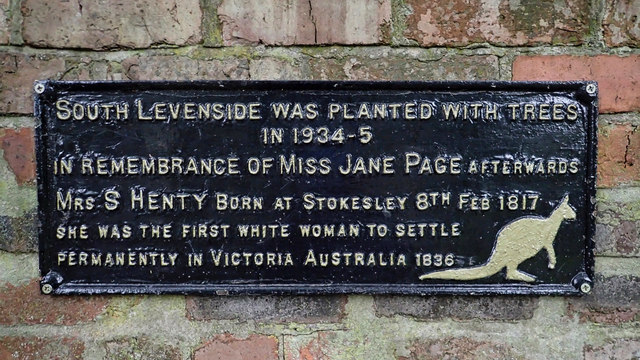Plaque on the Levenside, Stokesley
Introduction
The photograph on this page of Plaque on the Levenside, Stokesley by Mick Garratt as part of the Geograph project.
The Geograph project started in 2005 with the aim of publishing, organising and preserving representative images for every square kilometre of Great Britain, Ireland and the Isle of Man.
There are currently over 7.5m images from over 14,400 individuals and you can help contribute to the project by visiting https://www.geograph.org.uk

Image: © Mick Garratt Taken: 5 Oct 2018
I remember feeling very uneasy when I first read this plaque. And I feel just as uneasy today posting a photo of it. Is it too controversial, or am I just being over wary of offence? I googled Henty and found a Wikipedia page for the town of Henty in Victoria which says “The Henty and Merino area was the region of the first white settlement in what is now Victoria by the Henty brothers, starting in 1834”. I guess this was written by at least an Australian resident so the language must be acceptable there. As an amateur historian, I am aware that the words on a plaque can give valuable insights into the social attitudes at the time and this reaffirms that the belief in white superiority and the British Empire that was prevalent in Victorian times was strong in the 1930s and still resonates today. Miss Jane Page, then 17, travelled to Australia with her mother and a younger sister to join up with her father, a captain in the East India Company. On arrival at Fremantle near Perth, they were met on board by a party of colonists which included a Mr Stephen George Henty who, jointly with his brother Edward, was managing family land in Victoria. It seems the couple hit it off for they became “speedily engaged” with the marriage taking place soon afterwards. The couple immediately sailed on to Portland Bay, Victoria, arriving there in August 1836. On a promise of a grant of 62,000 acres of land, the Hentys first came to Australia from Sussex. They had brought with them 40 agricultural workers, and pure-bred cattle and merino sheep. Victoria seemed to be the family’s third attempt at establishing a farm, eventually building several sheep stations in the interior including the township of Henty. Mrs Jane Henty died in 1905 having spent 70 years in Australia. Three sons and three daughters survived her, with 13 grand and three great-grandchildren. Personally, I do find life stories like this fascinating but this one is not particularly remarkable. My concern is the wording on the plaque, which is passed by scores of children every school day. Any thoughts? From my blog http://www.fhithich.uk/?p=20287

